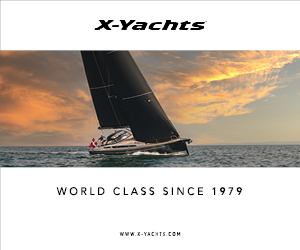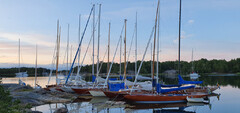Franck Cammas analyserar etapp 2 Volvo Ocean Race Cape Town - Abu Dhabi
En mycket intressant analys av Volvo Ocean Race så här långt och etapp 2 - enjoy!
Finishing in fourth place this Tuesday morning at 3h04'19 (UTC), the crew of Groupama 4 were understandably frustrated after a fine tactical coup which had taken them up into the lead of the fleet on entering the Doldrums. Franck Cammas reviews the past intense fortnight at sea in what proved to be a complicated forecast…
What are your first thoughts about this first part of the second leg?
“The last four days have been really terrible: we were in a very good position to win the leg. It's not easy to have lost so many places in two weather situations. They were certainly complicated, but we should have been able to traverse them better. However, even in hindsight, to traverse the Doldrums, it would have been hard to tackle it in any other way. We were happy with the first part of our race, with a start in light airs, where we managed the conditions well. As we passed the Agulhas Cap and again during the following night we sailed well by being the first to dip South. We were always surprised to see that no other boat struck out to the South in the way we did.”
But you really covered a lot of ground across the race zone!
“That's true but we didn't take a lot of risks in the sense that everyone was stuck on a North-South axis. We waited for the right time and the right place to attempt our option, but it wasn't quite the blinder we'd hoped for as it took us some time to edge our way around the high pressure zone.”
Have you overcome your failure in the first leg?
“Following the first leg we had a bit of a complex and weren't keen to go off on our own again away from the fleet. Ultimately though we took up our strategy again: when you're sure a move will work, you've got to go for it! Afterwards, there were some hybrid zones where luck wasn't on our side. The Doldrums were fatal for us. However, we were in a special situation as we had a lead of around a hundred miles…”
So why were the Doldrums so fatal for you?
“We quickly entered into it but midway through our route was barred. Basically, we benefited from an easterly wave which our pursuers weren't able to hook onto and, if everything had gone to plan, we should have been able to traverse it on a single tack. Once we were committed to that option, it was impossible to control the fleet who set off to the East. The entrance was very good at that point and we even came close to making good our escape at pace as we latched onto some north-westerly wind just hours before getting stuck. Unfortunately, the exit closed shut when the Doldrums shifted northwards and caught up with us.”
Was there no other choice?
“It's said that you have to head to the East for the Indian Doldrums, whilst in the Atlantic you have to traverse it to the West at around 30° West. But what does heading to the East mean? There isn't a lot of data, no established rules, no statistics to indicate one route over another. We were on a direct course! And we had wind…”
From shore though, we can see that two boats made considerable changes to their course…
“At that point, we were already within the system, even though we were then making 15-18 knots, at the edge of a mini depression. To the East, there was a windless zone of high pressure and it had become impossible to head back that way, whilst Camper and Telefonica had rounded this zone of high pressure a lot further offshore. As such we were above the zone of high pressure which Puma then fell into. The problem is that the Doldrums were climbing and had we been a few hours down the track, within twenty miles of where we were, we would have got free. Gaps open up extremely quickly!”
And how do you explain the end of the course?
“Our spirits had taken a knock and we weren't at all happy to have dropped down to third place. As such we tried one last option by going around the other side of an island. There was no more than three knots of breeze and the leaders had come to a standstill with two knots of current carrying them to the East. However, the wind kicked back in a bit too early and we weren't able to create enough separation.”
Then you dropped another place!
“I don't know if we lost it at that very moment as the Americans were already within sight astern of us and were faster in these light conditions. Puma is impressive in the light airs as we observed during the first part of the leg: she really moved up through the fleet very quickly! I know that looking at the situation from the outside, it's not pretty to watch, but this final option didn't change much: their consistent performance would have seen them overtake us anyway.”
It would seem that you play what is essentially a meteorological strategy while the other competitors play on tactical positioning.
“Our adversaries are certainly more conservative, essentially opting for the direct route each time. However, our southerly option in this second leg paid off! There's no taking that away from us… Especially as it wasn't thanks to a radical trajectory, it was just down to our separation. At sea, you don't know exactly where your competitors will go: you really have to take initiatives and not constantly stick to the pack if you want to win…”
As regards Groupama 4's performance, can you draw any lessons because, in contrast to the first leg, you were a lot more in contact with the others in some similar weather conditions?
“There weren't a lot of stable conditions and in the very light airs (less than five knots), it's hard to form an opinion. However, I think that we are very quick with over fifteen knots of true wind on the beam. We're not so at ease in the light airs (six-eight knots), especially against Camper. We're going to work on the shape of the sails.”
What do you think of the other teams after these two oceanic legs?
“The Spanish manage to get themselves out of some complicated situations and they are quite successful at it. They've won three races: congratulations! Unquestionably they're very quick when they're in contact with the other boats. However, their trajectory remains very conservative. I'm more impressed by Puma which is also very quick, but has some more honed objectives: I think they're the strongest team but they haven't been very lucky in these first two legs. Telefonica is clearly dominating! Camper has an excellent crew who can exploit the true potential of their boat, which manœuvres brilliantly, but I think that their boat lacks a certain something at high speeds. However, it is fearsome in light airs… Basically, everyone can win one leg!”
And Sanya's northerly option?
“It was very interesting as the routing was logical two to three days before they took the decision to mark their rivals. The option had even more appeal as the boat was the furthest North, like Telefonica, which was perfectly positioned! However, there was some uncertainty about the behaviour of the tropical depression… When Sanya set off, she came level with us offshore of Réunion Island, but if she'd gained some separation earlier, 24hrs to 30hrs before, she would have been way ahead of us, though she did have to endure very difficult seas!”
We can imagine that there was a huge amount of frustration when you saw that three boats had overtaken you!
“It's not a highlight but you just have to put up with it. As regards Puma getting past us, everyone agreed that we didn't have a lot to lose and maybe a lot to win. We weren't content with third place and we always hoped we'd be able to make a comeback. Of course we're questioning our logic and we're learning a great deal.”
Was it a collective decision to take an option?
“The whole crew is constantly updated about our decisions so they can be collectively taken into account. Jean-Luc and I spend a lot of time explaining and debating our options. However, each person has their own role because the strategic choices take a huge amount of time at the chart table. The crew also has to trim the sails and manœuvre… Not everyone can do everything. As such it's primarily down to regular explanation and communication.”
Next on the agenda is a short leg of just a hundred miles or so and an ‘in-port' race: have you made progress with this format?
“We probably aren't the most well-equipped crew for this type of race, even though we have nothing to be ashamed about in our manœuvres. Other teams like the Americans and the New Zealanders are really very at ease in this format. We still have a way to go… Instead we have a team with a good spirit, which is very good offshore and is tough. The races are tight and a lot could happen. It's not the Spaniards' strong point either and yet they won in Cape Town and they're leading the overall standing…”
What are you going to work on to make up this deficit during light air and contact racing?
“The light airs aren't favourable for us on paper. Camper is unquestionably the best performer. As such we're going to try to make gains in strength with the sail plan so as we can still power up in under eight knots of breeze. We're also going to modify the positions of the weight aboard, since we were more geared up for medium breeze. We're also going to work on refining certain trims. That doesn't mean we're going change the boat! If we can improve our performance in light airs, we'll have a highly versatile boat as we're at ease in the breeze. For the time being, the first two legs have had predominantly light airs, in contrast with statistics.”
How is this second part of the second leg shaping up?
“It's a direct course between Sharjah and Abu Dhabi: 75 miles. It may involve a long reach in medium airs or light airs close-hauled… However, it may also be windy!”
What's the programme for the coming days?
“We're going to get to Abu Dhabi as soon as possible and wait for the boat which should make Sharjah in early January. The day after the boats are unloaded, there's a coastal course.”
Are you in good shape physically?
“We're all a bit tired, but it's all in proportion. Clearly reaches tire you out! Fortunately, we make fast headway. Indeed it's very uncomfortable on these boats: it's incredibly wet, you get shaken about a lot and it's soaking down below. Three days of reaching at an average of over twenty knots is not something that you can take with a pinch of salt: it's intense!”
Provisional standing for the first part of the second leg
1-Telefonica (Iker Martinez) 24 points
2-Camper (Chris Nicholson) 20 points
3-Puma (Ken Read) 16 points
4-Groupama 4 (Franck Cammas) 12 points
5-Abu Dhabi (Ian Walker) 8 points
6-Sanya (Mike Sanderson) 0 point
Provisional overall standing after the first part of the second leg
1-Telefonica (Iker Martinez) 1+30+6+24 = 61 points
2-Camper (Chris Nicholson) 4+25+5+20 = 54 points
3-Groupama 4 (Franck Cammas) 2+20+2+12 = 36 points
4-Puma (Ken Read) 5+0+4+16 = 25 points
5-Abu Dhabi (Ian Walker) 6+0+3+8 = 17 points
6-Sanya (Mike Sanderson) 3+0+1+0 = 4 points

























